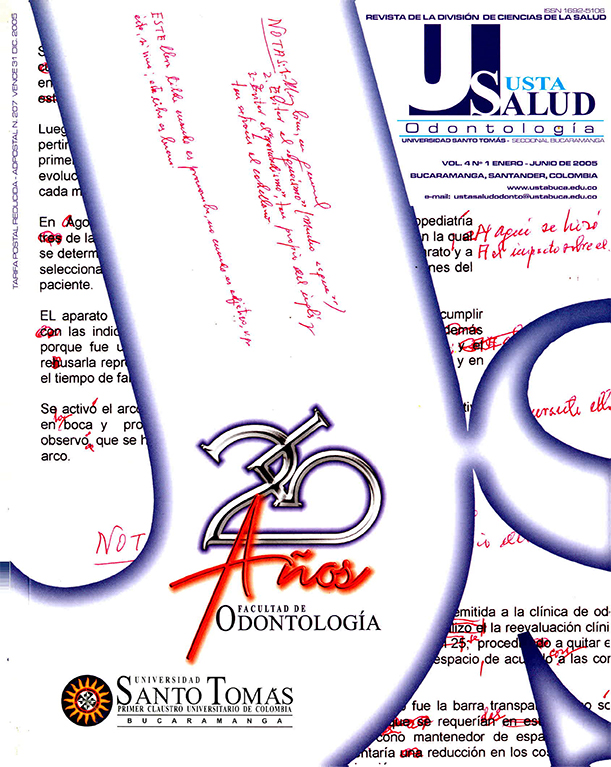MANEJO CLÍNICO DE UNA FRACTURA COMPLICADA DE CORONA: REPORTE DE UN CASO
Resumen
El trauma dental es una situación muy común en niños y adolescentes. Se presenta con frecuencia entre los 7 los 10 años de edad. Dentro de estas lesiones traumáticas se encuentra la fractura complicada de la corona que afecta en la mayoría de los casos a los incisivos centrales superiores. El propósito de este reporte de caso es mostrar la reposición del fragmento dental en una paciente que sufrió una fractura complicada de la corona.
[Riveros CM. Manejo clínico de una fractura complicada de la corona: reporte de un caso. Ustasalud Odontología 2005; 4: 59 - 64]
Referencias
2. Welburv RR. Traumatic injuries to the teeth. Pediatric Dentistry. Third Edition, 2005.
3. Douglass AB, Douglass JM. Common dental emergencies. Am Fam Physician 2003; 67: 511 - 516.
4. Slack GL. Jones JM. Psychological effect of fractured incisors. Br Dent J 1955; 99: 386 - 388.
5. León JC, Contreras E, Pineda L, Galeano CF. Prevalencia del trauma dentoalveolar en pacientes atendidos en el Servicio de Urgencias de la clínica Carlos Ardila Lülle de Floridablanca, Colombia, entre 1998 y 2002. Ustasalud Odontología 2004; 3: 32 -40.
6. Feiglin B. Dental pulp response to traumatic injuries - a retrospective analysis with case reports. Endod Dent Traumatol 1996; 12: 1 - 8.
7. República de Colombia, Ministerio de Salud. Resolución 00412. Guía de atención del menor maltratado. Bogotá, 2000.
8. Hermida MG. El niño con el cual trabajamos. Revista de la Academia Colombiana de Odontología Pediátrica 1998; 2: 17 - 20.
9. Andreasen JO, Andreasen FM. Classification, etiology and epidemiology. Textbook and color atlas of traumatic injuries to teeth. Copenhagen: Munksgaard, 1994: 151 -180.
10. Pinkham JR. Odontología pediátrica. 2da. Edición. McGraw-Hill Interamericana, 1994.
11. Flores MT, Andreasen JO, Bakland LK, Guidelines for the evaluation and management of traumatic injuries. Dent Traumatol 2001; 17: 97 - 102.
12. Uribe EJ. Operatoria dental: Ciencia y práctica. Ediciones Avances, 1995.
13. Andreasen FM. Biology of dental trauma: Pulpal considerations. Proceedings, 10 - 14.
14. Fucks A. Pulp therapy for the primary and young permanent dentitions. Dent Clin North Am 2000; 44: 571 - 596.
15. American Academy of Pediatric Dentistry. Guideline on pulp therapy for primary and young permanent teeth. Pediatr Dent Reference Manual 2002 - 2003; 24: 86 - 90.
16. Nolla CM. The development of the permanent teeth. J Dent Child 1960; 27: 254 - 266.
17. Turner C, Courts F, Stanley HR. A histological comparison of direct pulp caping agents in primary canines. J Dent Child 1987; 54: 423 - 428.
18. Rapelli G, Massaccesi C, Putignano A. Clinical procedures for the immediate reattachment of tooth fragment. Dent Traumatol 2002; 18: 281 - 284.
19. Robertson A, Andreasen FM, Bergenholtz G, Andreasen JO, Munksgaard C. Pulp reactions to restorations of experimentally induced crown fractures. J Dent 1998; 26: 409 - 416.
20. Robertson A, Andreasen FM, Bergenholtz G, AndreasenJO, Noren JG. Long-term prognosis of crown fractured permanent incisors. The effect of stage of root development and associated luxation injury. Int J Paediatr Dent 2000; 10: 191 - 199.
21. Ravn JJ. Follow-up study of permanent incisor with complicated crown fractures after acute trauma. Scand J Dent Res 1981; 89: 355 - 365.
22. Van Hazle HJ. Physiology of the human dental pulp. Oral Surg Oral Med Oral Pathol 1971: 32: 126 - 134.















